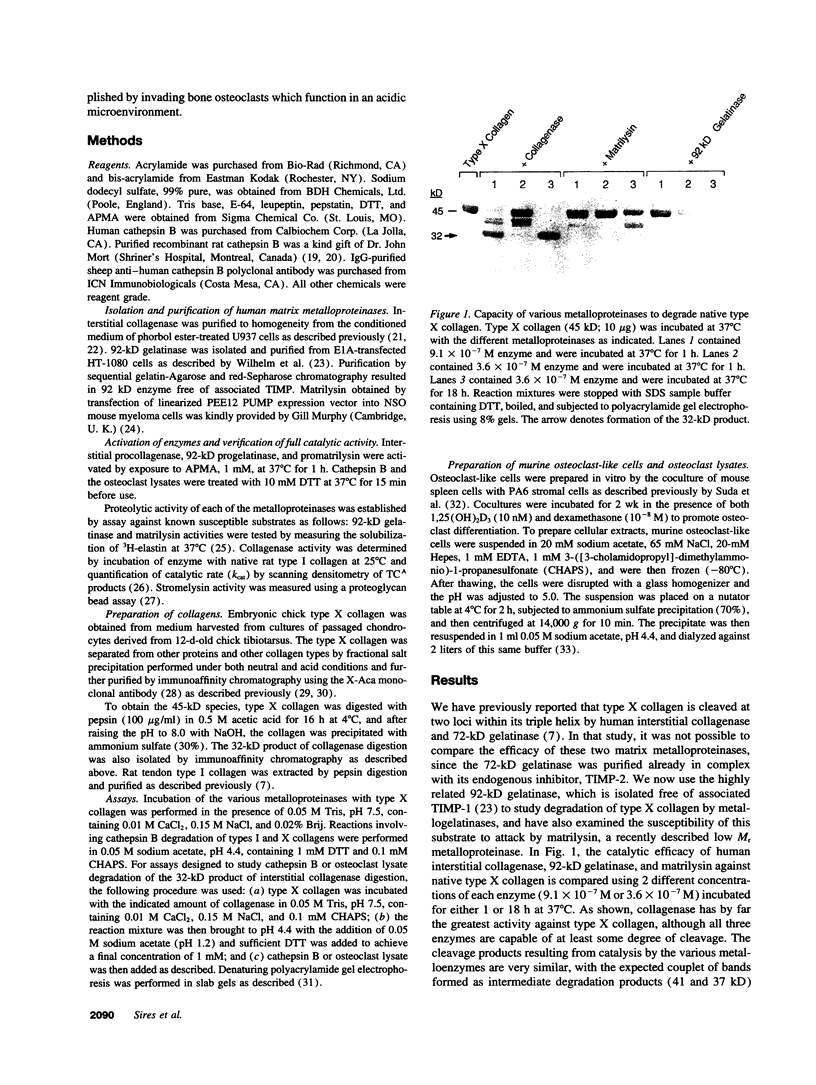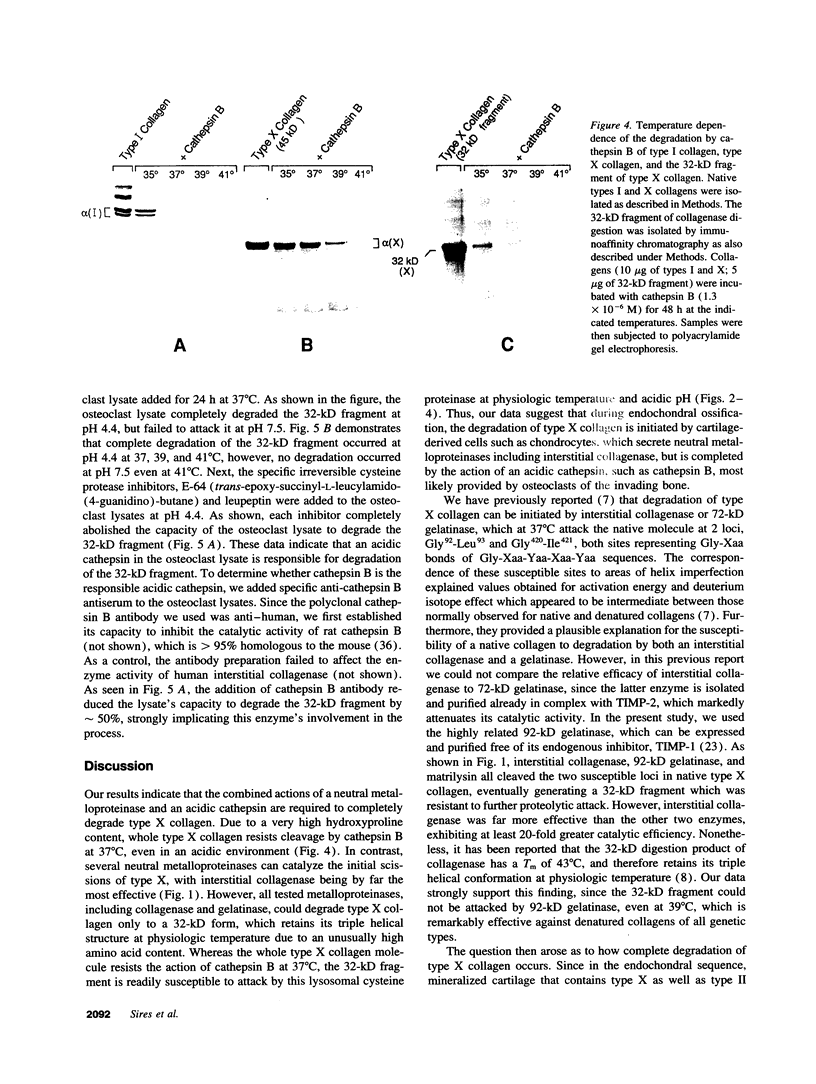Abstract
We have studied the degradation of type X collagen by metalloproteinases, cathepsin B, and osteoclast-derived lysates. We had previously shown (Welgus, H. G., C. J. Fliszar, J. L. Seltzer, T. M. Schmid, and J. J. Jeffrey. 1990. J. Biol. Chem. 265:13521-13527) that interstitial collagenase rapidly attacks the native 59-kD type X molecule at two sites, rendering a final product of 32 kD. This 32-kD fragment, however, has a Tm of 43 degrees C due to a very high amino acid content, and thus remains helical at physiologic core temperature. We now report that the 32-kD product resists any further attack by several matrix metalloproteinases including interstitial collagenase, 92-kD gelatinase, and matrilysin. However, this collagenase-generated fragment can be readily degraded to completion by cathepsin B at 37 degrees C and pH 4.4. Interestingly, even under acidic conditions, cathepsin B cannot effectively attack the whole 59-kD type X molecule at 37 degrees C, but only the 32-kD collagenase-generated fragment. Most importantly, the 32-kD fragment was also degraded at acid pH by cell lysates isolated from murine osteoclasts. Degradation of the 32-kD type X collagen fragment by osteoclast lysates exhibited the following properties: (a) cleavage occurred only at acidic pH (4.4) and not at neutral pH; (b) the cysteine proteinase inhibitors E64 and leupeptin completely blocked degradation; and (c) specific antibody to cathepsin B was able to inhibit much of the lysate-derived activity. Based upon these data, we postulate that during in vivo endochondral bone formation type X collagen is first degraded at neutral pH by interstitial collagenase secreted by resorbing cartilage-derived cells. The resulting 32-kD fragment is stable at core temperature and further degradation requires osteoclast-derived cathepsin B supplied by invading bone.
Full text
PDF






Images in this article
Selected References
These references are in PubMed. This may not be the complete list of references from this article.
- Barrett A. J., Kirschke H. Cathepsin B, Cathepsin H, and cathepsin L. Methods Enzymol. 1981;80(Pt 100):535–561. doi: 10.1016/s0076-6879(81)80043-2. [DOI] [PubMed] [Google Scholar]
- Blair H. C., Teitelbaum S. L., Grosso L. E., Lacey D. L., Tan H. L., McCourt D. W., Jeffrey J. J. Extracellular-matrix degradation at acid pH. Avian osteoclast acid collagenase isolation and characterization. Biochem J. 1993 Mar 15;290(Pt 3):873–884. doi: 10.1042/bj2900873. [DOI] [PMC free article] [PubMed] [Google Scholar]
- Buck M. R., Karustis D. G., Day N. A., Honn K. V., Sloane B. F. Degradation of extracellular-matrix proteins by human cathepsin B from normal and tumour tissues. Biochem J. 1992 Feb 15;282(Pt 1):273–278. doi: 10.1042/bj2820273. [DOI] [PMC free article] [PubMed] [Google Scholar]
- Burleigh M. C., Barrett A. J., Lazarus G. S. Cathepsin B1. A lysosomal enzyme that degrades native collagen. Biochem J. 1974 Feb;137(2):387–398. doi: 10.1042/bj1370387. [DOI] [PMC free article] [PubMed] [Google Scholar]
- Chan S. J., San Segundo B., McCormick M. B., Steiner D. F. Nucleotide and predicted amino acid sequences of cloned human and mouse preprocathepsin B cDNAs. Proc Natl Acad Sci U S A. 1986 Oct;83(20):7721–7725. doi: 10.1073/pnas.83.20.7721. [DOI] [PMC free article] [PubMed] [Google Scholar]
- Chang J. C., Lesser M., Yoo O. H., Orlowski M. Increased cathepsin B-like activity in alveolar macrophages and bronchoalveolar lavage fluid from smokers. Am Rev Respir Dis. 1986 Sep;134(3):538–541. doi: 10.1164/arrd.1986.134.3.538. [DOI] [PubMed] [Google Scholar]
- Delaissé J. M., Eeckhout Y., Vaes G. In vivo and in vitro evidence for the involvement of cysteine proteinases in bone resorption. Biochem Biophys Res Commun. 1984 Dec 14;125(2):441–447. doi: 10.1016/0006-291x(84)90560-6. [DOI] [PubMed] [Google Scholar]
- Etherington D. J. The dissolution of insoluble bovine collagens by cathepsin B1, collagenolytic cathepsin and pepsin. The influence of collagen type, age and chemical purity on susceptibility. Connect Tissue Res. 1977;5(3):135–145. doi: 10.3109/03008207709152264. [DOI] [PubMed] [Google Scholar]
- Gadher S. J., Eyre D. R., Wotton S. F., Schmid T. M., Woolley D. E. Degradation of cartilage collagens type II, IX, X and XI by enzymes derived from human articular chondrocytes. Matrix. 1990 Jul;10(3):154–163. doi: 10.1016/s0934-8832(11)80164-2. [DOI] [PubMed] [Google Scholar]
- Gibson G. J., Beaumont B. W., Flint M. H. Synthesis of a low molecular weight collagen by chondrocytes from the presumptive calcification region of the embryonic chick sterna: the influence of culture with collagen gels. J Cell Biol. 1984 Jul;99(1 Pt 1):208–216. doi: 10.1083/jcb.99.1.208. [DOI] [PMC free article] [PubMed] [Google Scholar]
- Gibson G. J., Schor S. L., Grant M. E. Effects of matrix macromolecules on chondrocyte gene expression: synthesis of a low molecular weight collagen species by cells cultured within collagen gels. J Cell Biol. 1982 Jun;93(3):767–774. doi: 10.1083/jcb.93.3.767. [DOI] [PMC free article] [PubMed] [Google Scholar]
- Grant W. T., Wang G. J., Balian G. Type X collagen synthesis during endochondral ossification in fracture repair. J Biol Chem. 1987 Jul 15;262(20):9844–9849. [PubMed] [Google Scholar]
- Hasnain S., Hirama T., Tam A., Mort J. S. Characterization of recombinant rat cathepsin B and nonglycosylated mutants expressed in yeast. New insights into the pH dependence of cathepsin B-catalyzed hydrolyses. J Biol Chem. 1992 Mar 5;267(7):4713–4721. [PubMed] [Google Scholar]
- Howie A. J., Burnett D., Crocker J. The distribution of cathepsin B in human tissues. J Pathol. 1985 Apr;145(4):307–314. doi: 10.1002/path.1711450404. [DOI] [PubMed] [Google Scholar]
- Hyashi T., Curran-Patel S., Prockop D. J. Thermal stability of the triple helix of type I procollagen and collagen. Precautions for minimizing ultraviolet damage to proteins during circular dichroism studies. Biochemistry. 1979 Sep 18;18(19):4182–4187. doi: 10.1021/bi00586a022. [DOI] [PubMed] [Google Scholar]
- Isemura M., Yosizawa Z., Takahashi K., Kosaka H., Kojima N., Ono T. Characterization of porcine plasma fibronectin and its fragmentation by porcine liver cathepsin B. J Biochem. 1981 Jul;90(1):1–9. doi: 10.1093/oxfordjournals.jbchem.a133437. [DOI] [PubMed] [Google Scholar]
- Kwan A. P., Sear C. H., Grant M. E. Identification of disulphide-bonded type X procollagen polypeptides in embryonic chick chondrocyte cultures. FEBS Lett. 1986 Oct 6;206(2):267–272. doi: 10.1016/0014-5793(86)80994-2. [DOI] [PubMed] [Google Scholar]
- Laemmli U. K. Cleavage of structural proteins during the assembly of the head of bacteriophage T4. Nature. 1970 Aug 15;227(5259):680–685. doi: 10.1038/227680a0. [DOI] [PubMed] [Google Scholar]
- Maciewicz R. A., Etherington D. J. A comparison of four cathepsins (B, L, N and S) with collagenolytic activity from rabbit spleen. Biochem J. 1988 Dec 1;256(2):433–440. doi: 10.1042/bj2560433. [DOI] [PMC free article] [PubMed] [Google Scholar]
- Maciewicz R. A., Wotton S. F., Etherington D. J., Duance V. C. Susceptibility of the cartilage collagens types II, IX and XI to degradation by the cysteine proteinases, cathepsins B and L. FEBS Lett. 1990 Aug 20;269(1):189–193. doi: 10.1016/0014-5793(90)81151-d. [DOI] [PubMed] [Google Scholar]
- Murphy G., Cockett M. I., Ward R. V., Docherty A. J. Matrix metalloproteinase degradation of elastin, type IV collagen and proteoglycan. A quantitative comparison of the activities of 95 kDa and 72 kDa gelatinases, stromelysins-1 and -2 and punctuated metalloproteinase (PUMP). Biochem J. 1991 Jul 1;277(Pt 1):277–279. doi: 10.1042/bj2770277. [DOI] [PMC free article] [PubMed] [Google Scholar]
- Nagase H., Woessner J. F., Jr An improved assay for proteases and polysaccharidases employing a cartilage proteoglycan substrate entrapped in polyacrylamide particles. Anal Biochem. 1980 Sep 15;107(2):385–392. doi: 10.1016/0003-2697(80)90400-5. [DOI] [PubMed] [Google Scholar]
- Nguyen Q., Mort J. S., Roughley P. J. Cartilage proteoglycan aggregate is degraded more extensively by cathepsin L than by cathepsin B. Biochem J. 1990 Mar 1;266(2):569–573. [PMC free article] [PubMed] [Google Scholar]
- Rowan A. D., Mason P., Mach L., Mort J. S. Rat procathepsin B. Proteolytic processing to the mature form in vitro. J Biol Chem. 1992 Aug 5;267(22):15993–15999. [PubMed] [Google Scholar]
- Schmid T. M., Conrad H. E. A unique low molecular weight collagen secreted by cultured chick embryo chondrocytes. J Biol Chem. 1982 Oct 25;257(20):12444–12450. [PubMed] [Google Scholar]
- Schmid T. M., Linsenmayer T. F. A short chain (pro)collagen from aged endochondral chondrocytes. Biochemical characterization. J Biol Chem. 1983 Aug 10;258(15):9504–9509. [PubMed] [Google Scholar]
- Schmid T. M., Linsenmayer T. F. Denaturation-renaturation properties of two molecular forms of short-chain cartilage collagen. Biochemistry. 1984 Jan 31;23(3):553–558. doi: 10.1021/bi00298a024. [DOI] [PubMed] [Google Scholar]
- Schmid T. M., Linsenmayer T. F. Immunohistochemical localization of short chain cartilage collagen (type X) in avian tissues. J Cell Biol. 1985 Feb;100(2):598–605. doi: 10.1083/jcb.100.2.598. [DOI] [PMC free article] [PubMed] [Google Scholar]
- Schmid T. M., Mayne R., Jeffrey J. J., Linsenmayer T. F. Type X collagen contains two cleavage sites for a vertebrate collagenase. J Biol Chem. 1986 Mar 25;261(9):4184–4189. [PubMed] [Google Scholar]
- Senior R. M., Griffin G. L., Fliszar C. J., Shapiro S. D., Goldberg G. I., Welgus H. G. Human 92- and 72-kilodalton type IV collagenases are elastases. J Biol Chem. 1991 Apr 25;266(12):7870–7875. [PubMed] [Google Scholar]
- Silver I. A., Murrills R. J., Etherington D. J. Microelectrode studies on the acid microenvironment beneath adherent macrophages and osteoclasts. Exp Cell Res. 1988 Apr;175(2):266–276. doi: 10.1016/0014-4827(88)90191-7. [DOI] [PubMed] [Google Scholar]
- Sorrell J. M., Weiss L. The cellular organization of fibroblastic cells and macrophages at regions of uncalcified cartilage resorption in the embryonic chick femur as revealed by alkaline and acid phosphatase histochemistry. Anat Rec. 1982 Apr;202(4):491–499. doi: 10.1002/ar.1092020408. [DOI] [PubMed] [Google Scholar]
- Stricklin G. P., Bauer E. A., Jeffrey J. J., Eisen A. Z. Human skin collagenase: isolation of precursor and active forms from both fibroblast and organ cultures. Biochemistry. 1977 Apr 19;16(8):1607–1615. doi: 10.1021/bi00627a013. [DOI] [PubMed] [Google Scholar]
- Suda T., Takahashi N., Martin T. J. Modulation of osteoclast differentiation. Endocr Rev. 1992 Feb;13(1):66–80. doi: 10.1210/edrv-13-1-66. [DOI] [PubMed] [Google Scholar]
- Thomas G. J., Davies M. The potential role of human kidney cortex cysteine proteinases in glomerular basement membrane degradation. Biochim Biophys Acta. 1989 Mar 24;990(3):246–253. doi: 10.1016/s0304-4165(89)80041-8. [DOI] [PubMed] [Google Scholar]
- Welgus H. G., Connolly N. L., Senior R. M. 12-o-Tetradecanoyl-phorbol-13-acetate-differentiated U937 cells express a macrophage-like profile of neutral proteinases. High levels of secreted collagenase and collagenase inhibitor accompany low levels of intracellular elastase and cathepsin G. J Clin Invest. 1986 May;77(5):1675–1681. doi: 10.1172/JCI112485. [DOI] [PMC free article] [PubMed] [Google Scholar]
- Welgus H. G., Fliszar C. J., Seltzer J. L., Schmid T. M., Jeffrey J. J. Differential susceptibility of type X collagen to cleavage by two mammalian interstitial collagenases and 72-kDa type IV collagenase. J Biol Chem. 1990 Aug 15;265(23):13521–13527. [PubMed] [Google Scholar]
- Welgus H. G., Jeffrey J. J., Eisen A. Z. The collagen substrate specificity of human skin fibroblast collagenase. J Biol Chem. 1981 Sep 25;256(18):9511–9515. [PubMed] [Google Scholar]
- Wilhelm S. M., Collier I. E., Marmer B. L., Eisen A. Z., Grant G. A., Goldberg G. I. SV40-transformed human lung fibroblasts secrete a 92-kDa type IV collagenase which is identical to that secreted by normal human macrophages. J Biol Chem. 1989 Oct 15;264(29):17213–17221. [PubMed] [Google Scholar]







